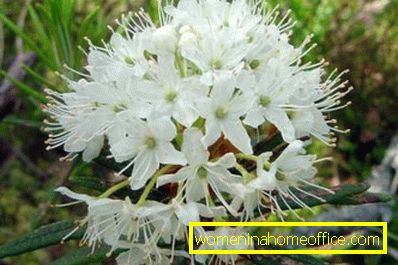Ledumberry marsh cough
Forest rosemary, marsh stupor, bagun, puzzle, stewed fruit, klopovnik - as soon as they do not call this plant, the encyclopedic name of which is "wild rosemary". In eastern medicine, it is widely used for the treatment of pulmonary tuberculosis, bronchitis, liver disease, and gynecology.
In Russian alternative medicine, wild rosemary has spread much later, however, still our herbalists use it as an expectorant, antitussive. The plant also has a bactericidal, antihypertensive, sedative effect.
reference
Ledum rosemary - an evergreen plant, shrub, belongs to the heather family, up to 2 m high, exudes a sharp stupefying smell, similar to camphor. The root system is superficial. Multiple ascending branches covered with red glandular hairs. The leaves are leathery, oblong, their edges are wrapped down, the top is dark green, shiny, the bottom is rusty brown, this part of the leaves is dotted with small yellow glands. The flowers are white, grow inflorescences - umbrella-shaped shields. The fruit is a long box. Flowering period: May - June, the plant bears fruit in July - August.
Where to looking for?
Ledum grows in the tundra and forests, on the peaty soils of marshes, on the marshy suburbs of pine forests in the form of extensive thickets.
Features of the collection
For medicinal raw materials, only fresh, not coarse shoots of the current year, up to 10 cm long. Collect raw materials from August to September, when there are fully developed shoots of the current year. Biennial and three-year shoots can not be harvested. The ability to regenerate in the marsh wild rosemary is very low, so the re-cutting of the shoots is done only 3 years after the first one - the plant will be required to restore the biological mass. It is necessary to dry a wild rosemary in an oven at a temperature of 30-40 ° C. You can also dry the raw materials in the shade under a canopy. With good weather, you will need 1.5-2 weeks. To dry, sprinkle the shoots with a thick layer (8-10 cm). You can keep such raw materials for 2-3 years.
Be careful when harvesting, drying and packing wild rosemary. This plant is poisonous, its strong smell can cause nausea, dizziness and headache. When working with this plant, be sure to use respirators and mittens; contact it for no more than 2-3 hours a day; after work, wash your hands thoroughly with soap and water.
Contraindications: It is not recommended to treat with wild roseum drugs for children under 14 years old
Side effects
Exceeding the dose of wild rosemary leads to excitation, and in severe cases - to the depression of the central nervous system. They should be used only as directed by the doctor, who must observe you all the time of treatment. If even a slight irritability, dizziness, and an increase in excitability are detected, they are immediately canceled. In addition, errors in dosage can lead to inflammation of the mucous membrane of the gastrointestinal tract.
Recipes
Cough infusion
Effective expectorant and bactericidal drug for the treatment of exacerbations of chronic bronchitis and other diseases of the lungs, accompanied by cough.
Pour 2 tablespoons of the grass of the marsh wild rosemary in an enamel pot, pour 200 ml of boiling water, cover and heat in a water bath for 15 minutes, then cool for 45 minutes at room temperature, remove the raw material and squeeze. The resulting infusion diluted with boiled water to 200 ml. Infusion should be stored in the refrigerator no more than 2 days. Take it slightly warmed to 50 ml 2-3 times a day after meals.

Asthma tea
Mix 4 tablespoons of wild rosemary and 2 tablespoons of nettle leaves. Pour the mixture with boiling water and leave to infuse for 12 hours at room temperature. Drink this tea should be 100 ml after each meal.

